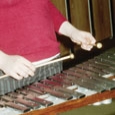This article originally ran in the February 1985 issue of The Instrumentalist.
One of the more difficult assignments for a percussionist to face is a musical passage calling for an immediate drop from a dynamic level of fortissimo to one marked pianissimo. Whether performing on snare drum, xylophone, or timpani, or any instrument of the percussion family struck with a mallet, one basic premise has to be understood: all dynamics on these instruments need to be controlled by stick or mallet height. So many drummers, when approached with this problem, head for the rim when playing snare, or move their mallets to the nodal point on a xylophone or marimba bar. This solution does indeed lower the dynamic level, but it also diminishes the quality and timbre of sound. Learning to control the mallet during a sudden drop from loud to soft is a process that needs to be practiced.
Suppose a snare drummer is faced with one of the following passages:
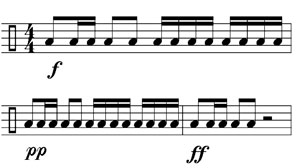
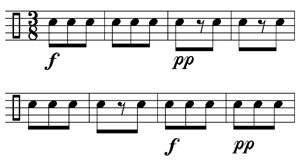
Both examples illustrate an immediate change from ff to pp, with no decrescendo or diminuendo indicated by the composer. In judging of various contests on the high school and symphonic levels, I have witnessed players attempting the change in dynamics by using a quick diminuendo or crescendo to reach the new level – but not accomplishing this until after the fact. To make sure, in example 1, that the last 16th note in the first measure is and beat one in the second measure is pp, I suggest the following sticking:
.jpg)
In other words, use a paradiddle RLRR for the fourth beat, with the RR giving the player ample time to quickly position the left stick a half-inch off of the rim, ready and waiting to begin measure two at pp. With practice, this concept works very well and enables the player to keep the flow of the rhythm intact. The problem of alternating dynamic levels frequently can be solved this way:
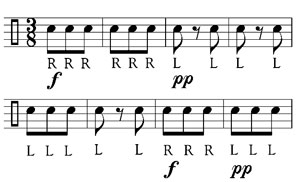
Here, with both sticks striking the same spot on the head, the player’s right hand represents “loud” and is positioned accordingly above the drum, while his left hand represents “soft” and stays about one inch off the head through the passage. Again, control of the weaker hand and thus the dynamic level can be achieved through practice. It is ideal to practice in front of a mirror.
For the mallet instruments, especially the xylophone, immediate dynamic control happens through much the same technique. Where, because of the contour of a particular phrase, a double-sticking is inappropriate, the player should practice “digging in” with the last two strokes and leave his mallets a half-inch off the bar in preparation for the ensuing pp section:
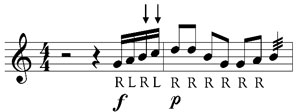
Where appropriate, single sticking of a particularly soft passage with the mallet no more than an inch above the bar is most effective at achieving the desired drop from fortissimo to pianissimo, following a loud alternated pattern:
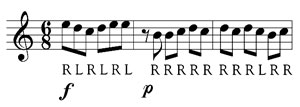
Going from ff to pp on the timpani can usually be achieved through lowered mallet height, but with timpani, muffling of the loud passage is necessary and presents problems:


Here, the player treats the quarter-note on beat three as an eighth note, followed by a quick muffle on the second half of three with the left hand, effectively killing the sound before the ensuing piano level in the second measure. Another, but less recommended method would have the muffling occur in place of beat one in the second measure, and then playing beat two softly:

Whether on snare drum, xylophone, or timpani, playing dynamic drops from loud to soft is possible through many of the techniques described above. For today’s percussionist, the aim is to play the dynamic change as musically as possible.
